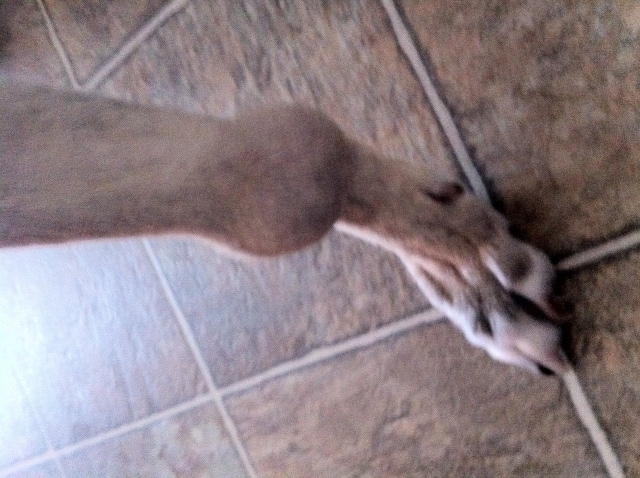QuestionHi Terry
This may be an allergy problem or something else. My beagle gets wax buildup in his ears that I regularly clean out with cue tips. However, it is much worse in one ear than the other. That ear also often gets red and irritated on the inside with flaking skin, causing him to scratch it, which I think only makes the problem worse.
A vet once told us we could apply neo-sporin to his ear. I have been doing this sometimes, which seems to help with the redness. However, my wife thinks we should only use neo-sporin if it is infected. She recommends I put aloe lotion in his ears. Do you have any advice on this? Thanks. Chris
AnswerChris,
The best thing I can do for you is to give you some information regarding ear infections. Hopefully your dog has been tested for other underlying problems. If not, I would highly recommend that you have tests done to rule out more severe conditions such as Cushings disease.
Most ear infections in dogs affect the portion of the ear canal that lies between the visible external ear and the ear drum. Infections in this portion of the ear are referred to as otitis externa. Infections in this region most commonly involve bacteria, with yeast being the next most likely problem. This is also the region in which ear mites establish themselves when they manage to infect a dog or cat. Otitis externa can be very painful but it does not cause balance problems and only rarely affects a dog or cat's appetite. There is usually an underlying cause for cases of otitis externa, since a normally functioning ear canal resists infection pretty well. The most common underlying cause is allergy, then probably
immunosuppressive disorders (Cushing's would fall in this category) and then hormonal disorders, with hypothyroidism being the most common hormonal disorder associated with persistent ear infections. Identifying and treating an underlying cause can make it possible to manage ear infections that would otherwise not respond to treatment. Identifying the infecting organism is sometimes possible through examination of a smear of ear contents under a microscope. Culture and sensitivity testing of the ear
canal can also be beneficial. Many cases of otitis externa can be treated with topical medications. In the case of corticosteroids, which are found in many ear medications, there is a systemic effect from topical application in most instances, although it may be slight in many cases.
Tresaderm Otic (Rx) does contain a corticosteroid, in addition to an antifungal agent and an antibiotic. It will usually kill ear mites, as well. It is one of the more commonly used topical medications. Despite the presence of Cushing's disease I usually opt for an ear medication containing a corticosteroid, as the benefits are usually good and the risk pretty minor.
Otitis media is infection of the portion of the ear from the inside of the ear drum to the beginning of the inner ear --- the portion often referred to as the middle ear. It is not uncommon to have both otitis externa and otitis media in the same patient. Estimates of the potential for both infections to be present vary a lot but it is probably at least 25% and may be as high as 50% or even more. The most common reason for this is rupture of the ear drum due to chronic otitis externa. A few patients probably have otitis media first. Otitis media can cause balance problems. Several of the veterinary ear medications can potentially cause problems if they penetrate to the level of the middle ear, so it is best, when possible, to visualize the ear drum and make sure it is intact. This can be very difficult in an infected, inflamed ear, though. Even though neomycin, the antibiotic in Tresaderm Otic may cause toxicity problems (usually deafness, less commonly balance problems) this is a rare problem in dogs and cats.
Otitis interna is infection of the inner ear. It often occurs without concurrent otitis media or otitis externa, although it is definitely possible for otitis media to lead to otitis interna eventually. Deafness, balance problems and facial paralysis are the signs most commonly associated with otitis interna. This is usually a bacterial problem and oral or injectable antibiotics are helpful.
The most common cause of balance problems in a dog is peripheral vestibular syndrome, which causes sudden loss of balance and usually results in decreased appetite, either due to an inability of the dog to eat effectively or due to nausea associated with the balance problems. If this was part of the problem it should have improved a great deal by now.
There are some dogs with Cushing's disease who do develop neurolgic signs or appetite problems (too much or too little appetite).
I hope you find this information helpful. Let me know what happens, I care.
Doe
doepiddle@charter.net

 mixed breed dog
QuestionSweetie Monster
QUESTION: hi this may be
mixed breed dog
QuestionSweetie Monster
QUESTION: hi this may be
 What is my dog
Question
This is the mystery do
a year ago a 11month ol
What is my dog
Question
This is the mystery do
a year ago a 11month ol
 Growth on dogs right foreleg
Question
Foreleg 1 Foreleg 2
Hi Gary,
Our
Growth on dogs right foreleg
Question
Foreleg 1 Foreleg 2
Hi Gary,
Our
 mini-schnauzer limping not able to put full weight on leg
Question
Willy
A couple of hours ago, I walked my 14mon
mini-schnauzer limping not able to put full weight on leg
Question
Willy
A couple of hours ago, I walked my 14mon
 Older dog with distended stomach.
Question
Belle
Hi, my 14 year old miniature dachshund,
Older dog with distended stomach.
Question
Belle
Hi, my 14 year old miniature dachshund,